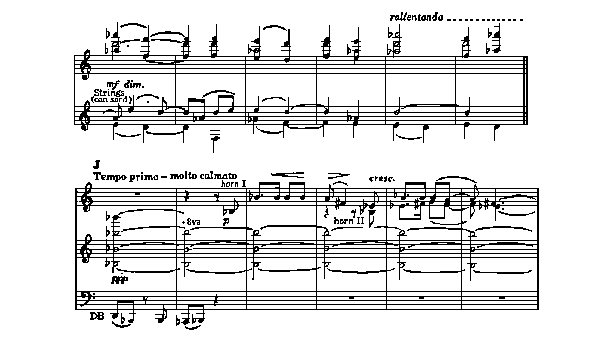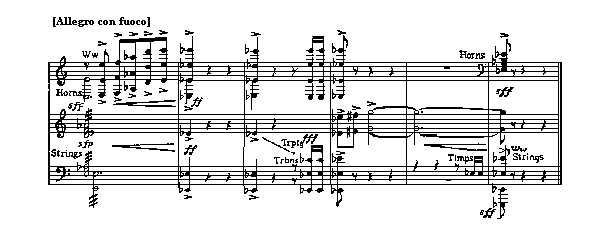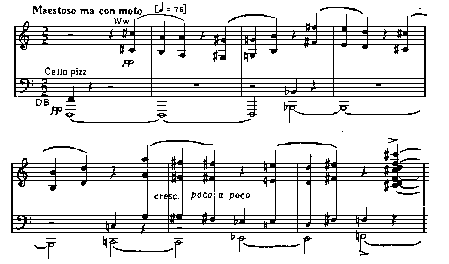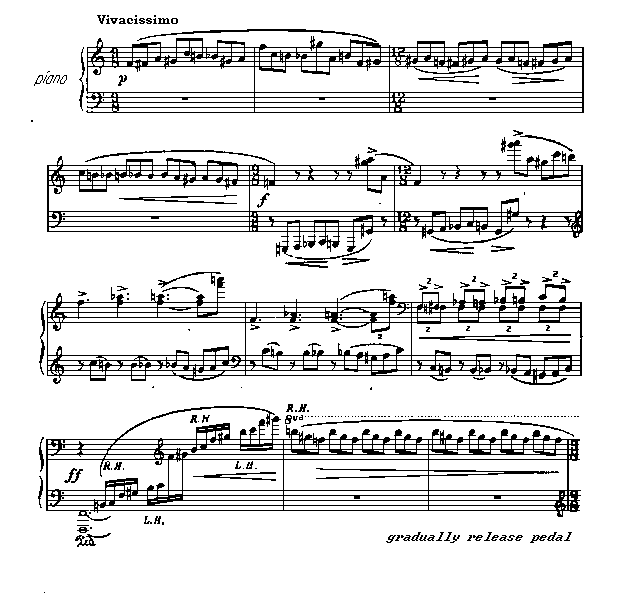|
|
Search MusicWeb Here |
|
 |
||
|
Founder:
Len Mullenger (1942-2025) Editor
in Chief:John Quinn
|
|
|
Search MusicWeb Here |
|
 |
||
|
Founder:
Len Mullenger (1942-2025) Editor
in Chief:John Quinn
|
Versatility is something that English people find hard to stomach, particularly in the world of the arts. To be a creative artist is bad enough, but to be not only a composer but also a professional flautist, a poet, an artist, an authority on pre-Raphaelite painting and a skilled translator of contemporary French poetry is almost unforgivable. Perhaps the best policy is to ignore such a talent - which is what seems to have happened to William Alwyn. Furthermore Alwyn the composer has always had a stigma attached to him. He has been a highly-successful composer of film music - indeed, has made a livelihood by it - and in the minds of those who are only able to see things in pigeon-hole terms, all his other music must be tainted by contact with this dangerously lucrative activity. It too has been labelled 'film-music', a foolish misconception, but one that has caused great harm to the composer's reputation.
There are other reasons why Alwyn's
music is not so well-known as that of his contemporaries.
Due to his agnostic beliefs he has never supplied
music for that familiar branch of the musical industry,
church music. This means that his name is not known
at all in the organ-loft or the choir-stall. A further
reason for neglect is an all-too-common one: his
music speaks in an idiom that is currently unfashionable.
He himself is an unashamed romantic, independent
and uncommitted. His artistic career has been the
pursuit of beauty, like an artistic Don Juan. In
fact his most ambitious work is an opera based on
the life of a contemporary Don Juan-figure which
sums up his ideas and ideals of the artist in society.
The epitome of his philosophy can be found in the
'Envoi' of his poem, Winter in Copenhagen
If there is any hope of resurrection in Alwyn's philosophy it is not a blaring final trumpet or singing choir of angels that will herald it:
As with any true artist, this philosophy is matched by his creative work and though his symphonies and chamber music cannot speak for themselves, they clearly embody this attitude to life in their very existence.
Alwyn has never sought to intrude extraneous details onto his music. He rarely furnishes a programme note or publicises his activities. His career and output of works are therefore little known compared with his contemporaries Rawsthorne, Tippett and Lutyens. He was born in Northampton on November 7th, 1905, four years after Edmund Rubbra and sixteen years before Malcolm Arnold. 'It is odd', he has written , 'that a boot-manufacturing provincial town, musically isolated and unpromising ground, should have produced three composers', and indeed he has little to thank Northampton for from a musical point-of-view. His father was a Londoner who had moved to the town and opened a grocery business. He was a self-educated but well-read man with a particular love for Shakespeare. He even went so far as calling his grocery-business 'The Shakspere Stores' and adorning his wrappers and paper-bags with pertinent, and often punning, Shakespearean quotations. Though there was no particular interest in music in the family, his father left his son with an abiding love of literature. Alwyn, however, showed musical leanings as a boy and was given lessons in flute and piano by local musicians. His first composition was a piccolo solo entitled Sparkling Cascades, written at the age of eight 'in emulation of my heroes at that time-the military band who performed in Abington Park'.
He went to school locally but left at the age of fourteen to help in his father's shop. His piano teacher, however, managed to persuade his father to send him to the Royal Academy of Music. Here he won a flute scholarship and later the Sir Michael Costa scholarship for composition which enabled him to study with John B. McEwen, whom he describes as 'a most enlightened and unacademic teacher'. This happy period of study did not last long, for when he was eighteen his father died suddenly and subsequent financial difficulties at home forced him to abandon his scholarship and take up the first job available. This happened to be at a prep school in Haslemere, "an utterly uncongenial year', he describes it, 'except for a summer of cricket, a game for which I had considerable talent.' This was followed by a spell playing the flute in theatre- and cinema-pits and teaching piano at a shilling an hour in the East End of London. Then, in I926, McEwen was appointed Principal of the R.A.M. and Alwyn was invited to join his staff as a professor of composition. Here he remained until he resigned in I955, numbering amongst his pupils Iain Hamilton, Steve Race and John Manduell.
Alwyn's first important opportunity as a composer came during the I927 Promenade Concert season when Sir Henry Wood conducted his Five Preludes for Orchestra (a work subsequently withdrawn). He was to repay Sir Henry's fondness and early encouragement in 1964 with his third Concerto Grosso, Tribute to Sir Henry Wood, which was performed during the 70th season of the Proms. His first contact with film music came in 1935 when he was asked at short notice to compose music for a documentary on air travel, The Future is in the Air. The experience he was to gain in the following years led him to be chosen, when war broke out, for special duties as a composer for feature films and documentaries, such as The Way Ahead and Desert Victory. This was virtually propaganda work and his contribution to the war effort seems to have been very effective, for he holds the dubious honour of having his name on Hitler's official 'black list'. With the war at an end his services as a film composer were inevitably in great demand, and until the early 1960s - when he gave up films - he earned a substantial part of his livelihood in this way: 'bought time', in his own words, for his more important compositions.
His interest in films, however, has been far deeper than that of financial reward. He became very interested in the potentials of the medium and explored the new possibilities and techniques that the medium offered, particularly the use of music to 'counterpoint' the filmed action rather than to act merely as a 'mood stimulus'. 'Its main fascination for me', he has said,' 'is the rhythmic relationship and interplay of the spoken word and music'. Alwyn's innovations in this area are discussed by Hans Keller in his article, Film Music: Speech Rhythm and his pioneering work was recognised by the film industry itself in 1958 when he was elected a Fellow of the British Film Academy.
Unfortunately this very professionalism has led, as I have mentioned, to specious criticism of his other music. Yet it is essential to recognise that, for Alwyn, film music was, no more, no less, musical journalism. This does not imply that he did not take composing for films seriously. Just like a novelist or poet who earns his livelihood as a journalist, he put his very best into his work. And he certainly did not try, as so many composers do, to separate his music into 'film' and .serious'. The musical style of his film-music was essentially no different from that of his concert-room music. And it was precisely this, I feel, that brought about the cries of 'Film music!' onto his symphonies and tone poems. Alwyn has been one of the most prolific film composers in this country, with nearly thirty years of films behind him and, moreover, he was working at a time when cinema-going was at its peak popularity. Inevitably we have had the style Alwyn ringing in our cars for many years, and with the many television replays of these films this unconscious familiarity continues. 'Film-music!' The criticism is ill-considered and pernicious, for his orchestral and chamber music is quite un-cinematic in its techniques. They are abstract works, with no visual or verbal requirements to make them effective.
The first work that Alwyn now acknowledges is his Divertimento for solo flute, written in 1939. He had of course composed a great deal of music before this, including an oratorio, to poems by Blake, The Marriage of Heaven and Hell (1936), but today he considers these works as juvenilia, lacking security of technique. The Divertimento was first performed at the ISCM festival in New York in 1940 by Rene Le Roy and is a work of complete technical assurance. Its virtuoso character - it includes amongst its movements a three-part fugue - is an indication of the composer's prowess as a flautist and it remains one of the most important works in the flute repertoire. Since 1939 his output has been a steady one, with orchestral works predominating: overtures, symphonies, concertos and - for want of a better term - tone poems. In addition there is some important chamber music - the String Quartet (I955) and the String Trio (1962) - and works for solo piano. There are, significantly, no choral works and only one song cycle - his recent Mirages (I970).
The earlier works all bear traces of Alwyn's preoccupation at that time with neo-classicism. This can clearly be recognised in his first two Concerto Grossos (1942 and 1950) and the Sonata Alla Toccata (1942). Subsequent works, however, are much more romantic in style. This romanticism, already evident in the Oboe Concerto (1944) and in the slow movement of the second Concerto Grosso, reaches its peak in works of the mid-fifties, such as Lyra Angelica and Autumn Legend. Alwyn realised that, in some of these works, this spontaneous lyricism had become effusive and needed some form of harness. His adoption of neo-classical methods had earlier supplied a self-discipline, in the works written after 1955 he discovered a new discipline which was to prove far more fruitful. This was the use of 'limited modes', an idea originally suggest to him by Indian classical music. The modes that he uses consist of gamuts of (usually) four eight notes which act as the source for both melodic and harmonic material, a technique very akin to Schoenbergian serialism. Characteristically, the composer himself draws an analogy with painting rather than music, comparing these tonal restrictions with those of colour in the paintings of Picasso's 'blue' and 'pink' periods.
During the 1950s he wrote a cycle of four symphonies which, though divided from each other by a period of years, are best regarded as a 'set'. The third and fourth share his new modal technique and the Third Symphony (I956) is particularly instructive in its use. It is at the same time one of his most powerful utterances, and, from an autobiographical point-of-view, has interest enhanced by the fact that the composer kept a journal of the work's progress, which was later published in the International Review Adam. The journal not only provides a fascinatiing peep into a cornposer's workshop, but also indicates the hazards of creative work, particularly the interruptions - the 'Persons from Porlock' - to which nearly all artists have to submit in order to buy time and earn their daily bread. The journal in itself is an important document, worthy to stand beside the writings on music of Stravinsky and Tippett, and it deserves to be better known. But, despite its fascination, its real importance is as a pendant to the work in question and the Third Syrnphony is, in the opinions of those fortunate enough to have heard it, a very fine work indeed. John Ireland even went so far to describe it as 'the finest British symphony since the Elgar No.2 . . .' Rather typically, in view of the public neglect of Alwyn, it has received barely a dozen performances since Sir Thomas Beecham's remarkable first performance in 1956, and hardly any at all in the last ten years.
The syrmphony has three movements: Allegro Molto; Poco Adagio and Allegro con fuoco The First movement opens with a reiterated rhythmic motive, on horns, side drum and strings which eventually finds itself a melodic shape:

This theme contains the complete gamut of notes which Alwyn allows himself in this movement:

an eight-note mode bearing strong similarities to Messiaen's 'Second Mode of Limited Transposition'. The mode, with its particular emphasis on the intervals of the minor third and tritone generates the harmonic as well as the melodic material for the entire movement. As with a note-row, it supplies a unifying basis which allows the composer to explore a variety of melodic ideas and frees him from the necessity of direct thematic repetition. An interesting point is that this eight-note mode remains at the same pitch throughout (i.e. never transposed) even though there are clear changes of key centre. This means that the three main key centres of the movement (C - B - E-flat) have characteristic colourings, due to the different positions of notes within the key. This gives the music a variety of tonality that is both satisfying and completely unified in its effect.
The slow movement is based on an even more limited gamut, a mode consisting of four notes of the twelve-note scale missing in the previous mode.

Again there is an emphasis on the intervals of the minor third and tritone and again, except for one short episode, all the harmonic and melodic material of the movement is derived from those four notes in their untransposed form. It might be thought that this extreme form of restriction would act as jailer to the composer's imagination but in fact this movement is one of Alwyn's most magical creations. The very limitation of tones produces a remote and austere beauty. When (at fig.j, min.score) we are given a brief recollection of the first movement, the effect is stunning: we suddenly find ourselves in another world:

The nearest comparable effect that I know is in Debussy's Voiles (Preludes, Bk.II, bars 42-47) when, for a brief moment, the placid world of the whole-tone scale is broken - like the splash of a stone on water - by the sudden entry of the pentatonic scale. The outline is similar, but the emotional effect is however quite different. Here the new world that we enter is even more remote than the one we have left. The composer's journal entry for May 11th, 1956 describes the passage in question with restrained understatement: 'I have just approached the moment when the homs interrupt the incessant flow of the four notes... This and the re-statement pianissimo on muted strings which immediately follows excites me very much. "The homs of Elf-land faintly blowing" .
The Finale has many characteristics in common with the first movment, the most immediately noticeable being the use of a 'knocking' rhythm:

a common key-sequence (both move from C minor to E flat major) and long cantabile codas which reawaken to loud conclusions. Moreover the Finale retums to the eight-note world of the opening movement but in addition uses the four-note mode of the slow movement (see pp 144-151, min. score). The ending of the work draws the two modal worlds together:

Not only is the technique of the work brought to a logical conclusion, but also the emotional world of the whole symphony.
The Fourth Svmphony (1959) again explores the relationship of two modes, one of eight and one of four notes , each containing different notes of the 12-note scale. But this time the two ideas are counterpointed with each other from the outset:

TheTwelve Preludes for piano (1957) explore the same fruitful landscape in terms of the keyboard. Each prelude is based on a different gamut of notes, some of which are diatonic, some chromatic. No 5 in D (an elegy in memory of the pianist, Richard Farrell) uses what is basically a D-major scale with the addition of a minor sixth:

whilst No. 11 in D-flat is a tour-de-force in that its sixteen bars use no more than three different notes (D flat, E flat, F).
Alwyn's writing for the piano, here as in his more familiar Sonata alla Toccata, may not be startlingly original or innovatory, but it is a style that is entirely sympathetic to the medium, fitting the pianist's fingers like a glove. It reflects the composer's life-long love of the instrument, which can clearly be seen in this extract from Prelude No. 4 in F:

In some places in these preludes one feels that the limitations have proved to be a handicap rather than a stimulus to the composer's imagination. This sometimes leads (e.g. in Nos 7 in B and 12 in D) to monotony, and the variety of texture and colour that Alwyn has at his disposal in the syrnphonies is not compensated by the variety of the piano-writing.
Such criticism cannot in any way be directed at the String Trio (1962), Which is arguably his finest chamber work. Technically it can be seen as a logical conclusion to Alwyn's preoccupation with limited modes in that it is based on one mode which incorporates all twelve semitones. The technique has similarities with Schoenberg's twelve-note serialism, except that Alwyn does not allow himself the luxury of transposition. (There is an even clearer analogy between Alwyn's approach to and use of total chromaticism and that of Stravinsky - from the four- and five-note rows of the Three Shakespeare Songs and In Memoriam Dylan Thomas to the full twelve-note serialism of Threni - though the resulting music could hardly be more different.)
Since 1964 Alwyn's main energies have been devoted to the composition of his opera, Juan : or The Libertine, for which he wrote his own libretto. It is based on the Don Juan legend, particularly as recounted by Moliere, Byron and Flecker, but the events have been translated to a modern setting of the "not too distant future". The outline of the plot is as follows: Juan is the son of the Spanish Ambassador to London. The British 'President' - a close friend of Juan - is about to plunge the world into a nuclear war. To save the world, Juan kills the President, but to his horror the dead politician becomes a hero and there develops a legend that it was he who died to save the world. A statue of the late President is unveiled and in the final scene 'it' confronts Juan and preaches to him, explaining his folly and condemning him to eternal damnation. In counterpoint to these events, Juan - in traditional fashion - woos and discards a variety of women. (Such a brief synopsis, of course, tends to make the opera sound quite fantastic, as opera synopses invariably do. Try summing up, for example, The Midsummer Marriage or even Peter Grimes!) Alwyn's concept of Juan is obviously more complex than that of the lecher of tradition. The composer himself has said: 'I have always felt that although Don Juan was a libertine, he was also an artist and I have tried to create the Nietzschean picture of an artist taking the world into his own hands. I have imagined how an intelligent artist and individualist might face a world becoming less individualistic and try to change it. In the end he fails.
The score of Juan was completed in 1971. It now awaits performance. In an age when several young British composers, with far less dramatic experience than Alwyn, have had operas commissioned and produced, it would seem remarkably short-sighted if Juan were not given the opportunity to come alive on the stage. But the British musical scene can be remarkably shortsighted. How else can one explain the neglect of such masterly works as Lyra Angelica and the four symphonies? Perhaps the recent issues of recordings of his String Quartet, String Trio and piano music and the forthcoming recording of the Third Symphony will draw attention again to this undervalued composer. Though, knowing the curious British love of anniversaries, we may have to wait until 1975 for this to happen. Seventieth birthdays seem to have magical significance for the BBC and concert-promoting bodies - even if not for the composer and his audience.
 RETURN
TO HOME PAGE Biographies
RETURN
TO HOME PAGE Biographies